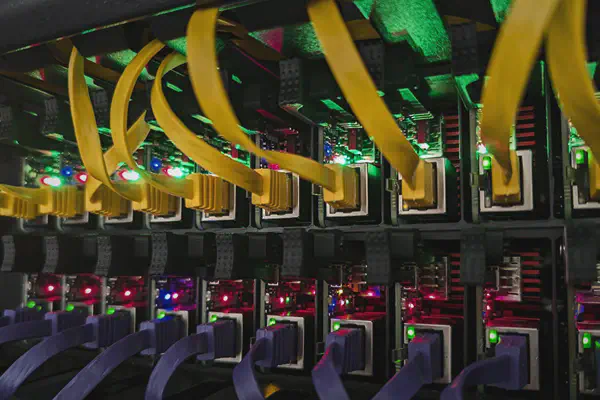This article will lead you through the necessary steps to install the Debian GNU/Linux operating system on a dedicated server at Hetzner.
Begin by accessing the Hetzner control panel, then navigate to the Robot control panel and, finally, the server list. Then, follow these steps:
- Identify the server and click on the server id (e.g.,
EX52-NVMe #1569272) to unfold the server details and management options. - Go to the
Rescuetab, select your public key 1 and click on theActivate rescuebutton. - Go to the
Resettab and select thePress power button of serverradiobutton, then click theSendbutton. The server will be powered off. Repeat the process to power it on. - Go to the
Firewalltab and make sure it allows access to port 22 via the TCP protocol.
Wait for a minute, then try to connect to the rescue system on port 22 using the root user and the key you selected before. We will be using InstallImage to install the operating system with a custom configuration but, first, we need to stop currently active software RAIDs and delete the current partitions to prevent possible issues during or after the installation.
mdadm --stop /dev/md/*
wipefs -fa /dev/sd*
wipefs -fa /dev/nvme*n1
You can check the current configuration with the
lsblkcommand.
Finally, let’s install the operating system via installimage by following these steps:
- Execute the
installimagecommand. - Choose
Debian. - Choose the most recent Debian 11 Bullseye image name.
By default, installimage will use all available disks to create a software RAID (RAID 1 if it finds two disks, RAID 5 if it finds four or more). This is fine for a server with just two NVMe disks for the OS and the local storage. However, this default configuration needs to be adapted when using a server with two disks dedicated to the OS and two or more disks dedicated to storage (e.g., a ZFS pool).
So, in the Midnight Commander user interface that will show next, change the level for the software RAID (SWRAIDLEVEL) from 5 to 1 and comment the hard disk drives that will not be used for the RAID of the disks dedicated to the operating system.
The following example is for a system with two NVMe disks for the OS and two HHD disks for the ZFS pool:
DRIVE1 /dev/nvme0n1
DRIVE2 /dev/nvme1n1
# DRIVE3 /dev/sda
# DRIVE4 /dev/sdb
SWRAIDLEVEL 1
Press F10 and select Yes to save the changes. Confirm the operation and monitor progress in the console. When the process finishes, type reboot to reboot the system into the newly-installed operating system.
OS configuration #
The base installation is Hetzner’s version of Debian AMD64 includes sudo, locales, net-tools and vim-tiny. There are some extra packages worth installing (adapt to your preferences).
apt-get update
apt-get install --yes ccze dnsutils htop jq nmap tcpdump
If you are using Vim as your text editor, remove nano and vim-tiny, then install the full version of Vim.
apt-get purge --yes nano vim-tiny
apt-get install --yes vim
Then set vim as the system-wide default editor and as the selected editor of the root user:
update-alternatives --set editor /usr/bin/vim.basic
echo 'SELECTED_EDITOR="/usr/bin/vim.basic"' > ~/.selected_editor
DNS entries #
For your convenience, set up A and, optionally, AAAA entries in your publicdomain.com DNS zone so that the host can be accessed through a FQDN:
proxmox1 IN A v4.public.ip.addr
proxmox1 IN AAAA v6:public:ip:addr::2
[..]
Hostname #
Configure the system hostname and related settings. Hetzner keeps a list of their data centres in their webpage. Check the end result with the hostnamectl status command.
hostnamectl set-hostname --static proxmox1
hostnamectl set-deployment "production"
hostnamectl set-chassis "server"
hostnamectl set-location "Data Center Park Falkenstein, Germany"
Adapt the list of static DNS entries at /etc/hosts. For simplicity, we will match the node number and the last digit of the IP address.
# IPv4
127.0.0.1 localhost.localdomain localhost
10.0.0.1 proxmox1.localdomain.com proxmox1
10.0.0.2 proxmox2.localdomain.com proxmox2
10.0.0.3 proxmox3.localdomain.com proxmox3
As we add nodes to the cluster beyond the first three ones, the list of mapped hosts in the /etc/hosts file of all nodes will have to be updated, not just on the new servers being added as nodes.
Support for IPv6 will be addressed in a separate series.
Locale #
Configure and generate the system-wide locale:
localectl set-locale LANG=en_US.UTF-8 LANGUAGE=en_US.UTF-8
locale-gen
And reboot. Check the content of the file /etc/default/locale to see which is the default locale.
Debian packages mirror #
Configure APT to use the German mirror as well as Hetzner’s by deleting the /etc/apt/sources.list.d/hetzner-security-updates.list file, then editing the /etc/apt/sources.list file.
# Packages and security updates from the Hetzner Debian mirror
deb http://mirror.hetzner.de/debian/packages bullseye main contrib non-free
deb http://mirror.hetzner.de/debian/packages bullseye-updates main contrib non-free
deb http://mirror.hetzner.de/debian/packages bullseye-backports main contrib non-free
# Debian mirror
deb http://ftp.de.debian.org/debian bullseye main contrib non-free
deb http://ftp.de.debian.org/debian bullseye-updates main contrib non-free
deb http://ftp.de.debian.org/debian bullseye-backports main contrib non-free
# Security updates
deb http://mirror.hetzner.de/debian/security bullseye-security main contrib non-free
deb http://security.debian.org/debian-security bullseye-security main contrib non-free
Update the packages index, then upgrade existing packages to their latest version:
apt-get update
apt-get dist-upgrade
Reboot.
Server time and timezone #
The Proxmox VE cluster stack relies heavily on the fact that all the nodes have precisely synchronized time. Debian uses systemd-timesyncd by default. Hetzner’s version includes three NTP servers, configured in the /etc/systemd/timesyncd.conf.d/hetzner.conf file.
You can check the status of the time synchronization using the timedatectl status command.
Servers should always store UTC. Local time is a presentation layer issue that only humans need to see. You can check the time zone in your server using the timedatectl status command. You can set the time zone to UTC with the timedatectl set-timezone Etc/UTC command.
Proxmox recommends using Chrony, so let’s install and configure it.
apt-get install chrony
This will have removed the systemd-timesyncd automatically. Edit /etc/chrony/chrony.conf and add Hetzner’s NTP servers. Also restrict requests to the hosts local network.
pool ntp1.hetzner.de ntp2.hetzner.com ntp3.hetzner.net iburst
allow 10.0.0.0/24
Restart Chrony with the systemctl restart chrony command, then check the status of time synchronisation using the chronyc sources command.
Adjusting the real time clock #
Should you need to adjust the system clock (software) and the real time clock (hardware), you can use the timedatectl command as well.
timedatectl set-ntp false
timedatectl set-time "2024-09-15 09:00:45"
timedatectl set-ntp true
The date and time have to be in the time zone of the system clock (UTC). The value of the hardware clock will be updated accordingly. An alternate method is to use the hwclock and date commands.
hwclock -r
date +%Y%m%d --set "20240915"
date +%T --set "09:00:45"
OpenSSH #
Edit the /etc/ssh/sshd_config file and make the following changes:
# Port 22
# Listen on port 2001 for external connections
ListenAddress v4.public.ip.addr:2001
# Listen to port 22 to let the Proxmox VE establish an SSH tunnel among hosts
ListenAddress 10.0.0.1:22
PermitRootLogin prohibit-password
PasswordAuthentication no
X11Forwarding no
# TCP Forwarding is required when migrating VMs
AllowTcpForwarding yes
AllowAgentForwarding no
AuthorizedKeysFile .ssh/authorized_keys
We are changing the default port 22 for the public IP address of the server and the plan is to use port 2001 for proxmox1, 2002 for proxmox2, 2003 for proxmox3, and so on. Choose whatever ports you fancy the most.
Proxmox requires that the node is listening on port 22 on the internal IP address of the node, hence the second ListenAddress directive.
Finally, TCP forwarding is required to migrate VMs. The rest is just disabling what is not needed and restricting access.
Check for syntax errors with sshd -t before restarting the service with the systemctl restart sshd command. Afterwards, check that the sshd daemon is now listening at the port of your choice.
netstat --program -all --numeric | grep --word-regexp LISTEN
Optionally, add the host to the .ssh/config file in your computer.
# Keep connections alive
Host *
ServerAliveInterval 60
ServerAliveCountMax 2
ControlMaster auto
ControlPath /tmp/%r@%h:%p
TCPKeepAlive yes
Host proxmox1
ControlMaster auto
User devops
Hostname proxmox1.publicdomain.com
Port 2001
IdentityFile ~/.ssh/devops
Host proxmox2
ControlMaster auto
User devops
Hostname proxmox2.publicdomain.com
Port 2002
IdentityFile ~/.ssh/devops
Host proxmox3
ControlMaster auto
User devops
Hostname proxmox3.publicdomain.com
Port 2003
IdentityFile ~/.ssh/devops
The
devopsuser will be created later in this article.
Check that you can connect to the server via SSH on port 2001 before exiting the current session on the default port. Adjust Hetzner’s firewall rules.
Fail2Ban on OpenSSH #
Fail2Ban offers protection against brute force attacks by banning hosts that cause multiple authentication errors. This prevents the attacker from trying out a large password list in a short time.
As of version 7.4 of Proxmox VE, its kernel uses iptables, which is used by Fail2Ban by default 2.
Install Fail2ban and enable the systemd service:
apt-get install fail2ban
systemctl enable fail2ban
Create a local configuration file /etc/fail2ban/jail.local with the following content, adjusting the port and the rest of parametres to your needs:
[DEFAULT]
# A list of IP addresses, CIDR masks or DNS hosts that Fail2ban will not ban
ignoreip = 127.0.0.1/8 ::1
# The number of seconds that a host is banned
bantime = 1d
# The number of failures before a host get banned
maxretry = 5
# A host is banned if it has generated "maxretry" during the last "findtime"
findtime = 1h
[sshd]
# As per /etc/ssh/sshd_config port configuration
port = 2001
[pam-generic]
# Default values of pam-generic already use the default backend,
# but we need to enable the jail
enabled = yes
SSH is the only service that is enabled by default, which can be checked at the /etc/fail2ban/jail.d/defaults-debian.conf file:
[sshd]
enabled = true
Restart the service to apply the changes, then check it is active over the sshd daemon using the fail2ban-client tool:
systemctl restart fail2ban
fail2ban-client status sshd
Electronic mail #
Proxmox uses email to send alarms and notifications, so the proxmox-ve package has postfix as a dependency. Postfix is a hugely-popular MTA designed to determine routes and send emails.
The most sensitive and practical way to organise system email delivery in all your hosts and guests is to use a relay host, i.e., applications will use the Postfix in the localhost and it will use a relayhost to deliver the email. In practice, this means that no email is delivered locally, but relayed, hence the term. A relay host is also known as a smart host or a relay server. This structure is known as a satellite system.
Postfix daemons in the nodes of the cluster will use the relay host of your email service provider, e.g., Zoho Mail, Proton Mail, and so on. To match this pattern, it would be recommended for Postfix daemons in the guests to use an internal relay host, such as Proxmox Mail Gateway, which will then relay the e-mails via your e-mail service provider as well.
Install Postfix via APT:
apt-get install mailutils postfix
Configure it as a satellite system. You will need to check the documentation of your e-mail service provider to complete this process. If you do not want to go through this right now, configure Postfix as local only and leave the system mail name as is (e.g., proxmox1.publicdomain.com). You can later change the configuration via the dpkg-reconfigure postfix command.
| Parametre | Value |
|---|---|
| Mail server configuration type | Satellite system |
| System mail name | proxmox1.publicdomain.com |
| SMTP relay host | relayhost.mailprovider.com |
| Root and postmaster mail recipient | root |
| Other destinations to accept mail for | proxmox1.publicdomain.com, localhost |
| Force synchronous updates on mail queue? | No |
| Local networks | 127.0.0.0/8 [::ffff:127.0.0.0]/104 [::1]/128 |
| Mailbox size limit (bytes) | 0 |
| Local address extension character | + |
| Internet protocols to use | all |
Edit the file /etc/aliases to properly map aliases to local user accounts and external email addresses.
postmaster: root
admin: root
debian: root
root: [email protected]
You need to run the newaliases command every time you change that file. Moreover, you will need to create the postmaster account or alias in your e-mail service provider control panel.
To test that the email sent by the node is reaching its destination, we can use the mail command from the mailutils package:
mail --subject="Test from $(hostname)" --append="From: <root@$(hostname -f)>" root@$(hostname -f) <<< "This is a test message from $(hostname -f) using the mail command."
By default, all nodes send notifications via email using the root@$hostname address.
Repeat the process in all the nodes of the cluster, as you install and configure them.
Non-root user #
You may want to create a normal user and add it to the sudo group for your daily maintenance routine. If so, first create a SSH key in your personal computer.
ssh-keygen -t ed25519 -a 100 -q -f ~/.ssh/devops -N '' -C "Proxmox VE DevOps"
Then, create the user in the server and set a password for it.
useradd --comment "DevOps User" --home /home/devops --create-home --shell /bin/bash --no-user-group --gid adm --groups sudo devops
passwd devops
Finally, add the key to the user and test connectivity and permissions.
su - devops
mkdir --mode=0700 ~/.ssh
echo "ssh-rsa <your '~/.ssh/devops.pub' key> devops@hostname" > ~/.ssh/authorized_keys
Make sure that you can acess through SSH with your usual key and that you can use sudo.



